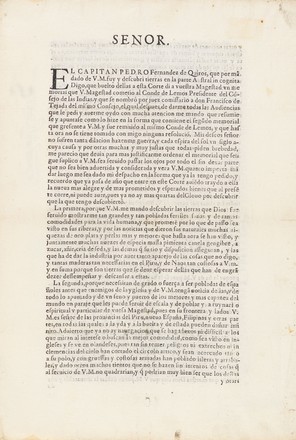
Senor. El Capitan Pedro Fernandez de Quiros, que por mãdado de V. M. fuy y descubri tierras en la parte Austral in cognita Digo ...
1608
SAFE 1/5q
Block print on laid paper
SAFE 1/5q
Block print on laid paper
Portuguese born Pedro Fernandes de Queirós (1563–1615) was an excellent navigator and cartographer, earning him a place as chief pilot on a Spanish voyage to colonise the Solomon Islands in 1595. Following this voyage to the Pacific Queirós became obsessed with seeking the mythical great southern continent – Terra Australis Incognita.
In 1602 Queirós approached Spain’s King Philip III to sponsor a new voyage of exploration with a letter of support from Pope Clement VIII. Within a year Queirós had obtained a royal order enabling the navigator to undertake an expedition for the discovery of the southern continent and ‘to win souls to heaven and kingdoms to the crown of Spain’.
In December 1605, Queirós – with Spanish navigator Luis Vaez de Torres as second in command – set out from Callao, Peru to realize his dream. The three ships sailed further south than ever recorded and in May 1606 sailed into a large bay of what they believed to be the great southern continent with Queirós naming it Austrialia del Espiritu Santo.
Upon departing the bay a bit over a month later into strong winds and a heavy sea, the flagship (San Pedro y Paulo) with an ill Queirós on board was permanently separated from the other two ships (San Pedro with Torres in command and the launch Los Tres Reyes). Ultimately Queirós’ ship headed back to Spain by 1607 where he spent the rest of his life seeking royal support for a return to Austrialia del Espiritu Santo to continue his spiritual mission.


 Back to list
Back to list